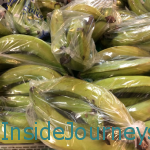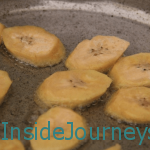The plantain is the tenth most important staple in the world and a very popular ingredient in the Jamaican diet. We fry it, boil it, bake it and make it into porridge, tarts and potato chips.
From the same family as the banana, the plantain looks very much like a large banana. Like the banana, both the green and yellow plantain are eaten. The yellow plantain is sweeter and softer than the green. Unlike the banana, though, we don’t usually eat them uncooked. A plantain has about 200 calories and is a very good source of vitamins and minerals.
I’d always preferred the ripe, slightly sweet plantains to the green ones until several years ago at a family gathering when one of my aunts made fried green plantains.
She cut three or four plantains diagonally about a quarter of an inch thick and fried them for a minute or two on each side. Once they turned reddish-brown, she lifted them from the pan, mashed them flat then returned them and fried them for another two minutes until they were crisp. When she finished, she served them with bully beef.
I couldn’t believe the taste – the mild saltiness of the bully beef was a delightful balance to the crispy, semi-sweet plantain – or that I’d previously ignored this delicious food. I couldn’t wait to return home to try it out and made plantains and bully beef every chance I got.
When I’m too tired or don’t feel like frying plantains – the yellow one is preferable – I bake them in the microwave, or oven (wrapped in foil) like I would a potato. I usually cut the tips off and score the skin lengthwise to allow it to expand as it cooks. For variety, you can also stuff the plantain with ground beef, for example, and bake it.
As you can see, plantains are quite versatile. Hope you pick some up the next time you’re in the supermarket.
Have a foodie post you’d like to share? Join the #FoodieTuesday linkup and add it here.
- Add the link to your food post in the link tool below.
- As a courtesy, please include a link back to this post.
- Please share the linkup love and leave a comment here and on as many posts as you can.
- If you Tweet, G+ or Facebook, please use the hashtag #FoodieTuesday
[inlinkz_linkup id=407186 mode=1]













































